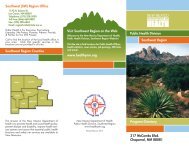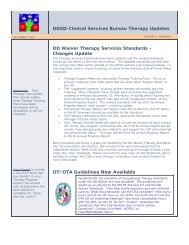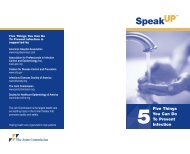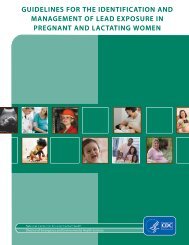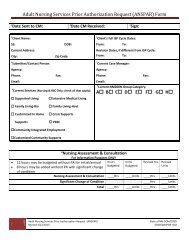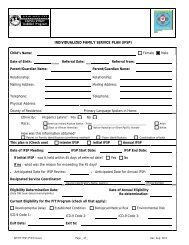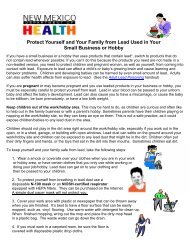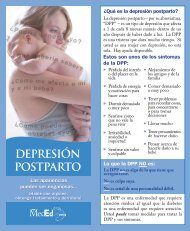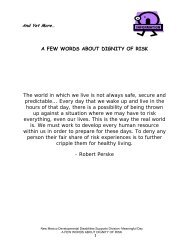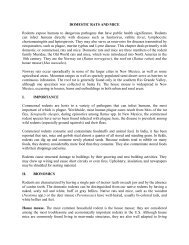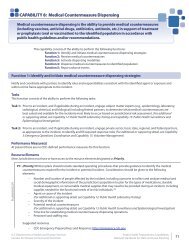INDIVIDUAL SERVICE PLAN for ADULTS INSTRUCTIONS
INDIVIDUAL SERVICE PLAN for ADULTS INSTRUCTIONS
INDIVIDUAL SERVICE PLAN for ADULTS INSTRUCTIONS
Create successful ePaper yourself
Turn your PDF publications into a flip-book with our unique Google optimized e-Paper software.
THE NARRATIVE SECTION<br />
This section documents the team’s comprehensive discussion with the individual about his/her life experiences,<br />
strengths, dreams, preferences (likes and dislikes), medical history, health status, general types of supports needed<br />
from both natural and paid sources (specific support strategies will come later) and personal description of meaningful<br />
day.<br />
• A description of self-advocacy ef<strong>for</strong>ts and/or leadership roles the person is involved with should be included under<br />
strengths and gifts.<br />
• Assessments are not merely referenced in the Narrative section, rather relevant findings and recommendations are to<br />
be synthesized and summarized.<br />
• The narrative sections capture what the individual wants <strong>for</strong> his/her future (long-term vision), progress towards<br />
reaching the long-term vision, and which outcomes the individual wants to work on in the near future, in relation to the<br />
vision.<br />
• The team’s discussion regarding these sections is the basis upon which action plans will be developed.<br />
It is strongly suggested that the first time this <strong>for</strong>mat is used with any individual, a separate<br />
meeting is held <strong>for</strong> the narrative section of the planning process, so that sufficient exploration<br />
of the individual’s history and future aspirations is facilitated. Then a separate meeting can be<br />
focused on the action - planning process, and individual specific training needs.<br />
_______________________________LIFE EXPERIENCES NARRATIVE______________________________<br />
LIFE EXPERIENCES:<br />
Provide background in<strong>for</strong>mation, including successful past experiences and major life events. Describe what life is like now and important<br />
relationships. Include a description of the individual’s values and beliefs that have resulted from these life experiences (e.g., personal, cultural,<br />
spiritual, political). Provide in<strong>for</strong>mation regarding personal challenges when applicable.( Do Not duplicate in<strong>for</strong>mation <strong>for</strong> upcoming sections on work,<br />
education, health and safety, strengths/gifts, preferences and hobbies, covered in later sections of this document.)<br />
Significant Historical In<strong>for</strong>mation:<br />
Greg was born in Belen, NM in 1978. He lived with his mother Sophia and father Martin on their small ranch until he was 21. He has no brothers or<br />
sisters, but is close with his Aunt Josie and two cousins, Justin and Jessica. He had many medical problems as a child (seizures, digestive problems<br />
and mild Cerebral Palsy). He had trouble learning to eat and needed help with his speech once he started pre-school. He loved the outdoors and<br />
spent lots of time tending horses with his father. He loved the rodeo and everything to do with ranch culture. He is proud of his Hispanic culture and<br />
attends St. Theresa’s Catholic church with his family on religious holidays. He walks with a slight limp now, but does well with regular PT exercises.<br />
He started pre-school at the local church at the age of 3 where he received SLP and PT services. He next tried a special education pre-school<br />
program and did not do well. His mother had him returned to his local church program. His therapists supported him at pre-school and home. He<br />
went to Meadowlark Elementary school where he attended both regular and special education classes. Greg’s mother is a great advocate and<br />
pushed the system so that he could attend as many regular education classes as possible. He was well liked and had a good experience. He<br />
needed several surgeries on his feet during this time and missed a lot of school. He went to Jarales Middle School. He was behind from the<br />
surgeries he had during elementary years and required tutoring and attended more special ed classes, despite ongoing advocacy from his mother.<br />
This was a difficult period <strong>for</strong> Greg and he had to work very hard. His digestive problems became more severe and he had trouble getting enough<br />
nutrients. He had several evaluations and tests <strong>for</strong> this problem and finally discovered that he had a severe allergy to wheat, known as Celiac<br />
disease. Once he started a gluten free diet, he had more stamina and felt better. (Celiac disease causes the body to attack itself (allergic reaction)<br />
and keeps the person from getting nutrition and can cause irritability, tiredness and pain.) Greg worked hard to graduate from high school; he liked<br />
the volunteer work he did through the school. He graduated Belen high school when he was 20, along with several of his friends. They had such a<br />
great celebration he still talks about it. He lost touch with his classmates after his move to Albuquerque<br />
Briefly describe progress made since last year:<br />
Now employed in a job he likes; depression has resolved; know his way around his neighborhood and is ready to spend some time alone.<br />
What life is like now (include where and with whom they live):<br />
Greg currently has a part-time job working with horses, which partially satisfies his desire to be recognized as a rancher (see<br />
Work/Education/Volunteer section <strong>for</strong> details). Greg tires easily due to Celiac’s disease. Greg attends 4-H meetings when he has transportation and<br />
6<br />
NM Developmental Disabilities Supports Division Individual Service Plan <strong>for</strong> Adults Instructions VERSION DATE: 5/30/2008



